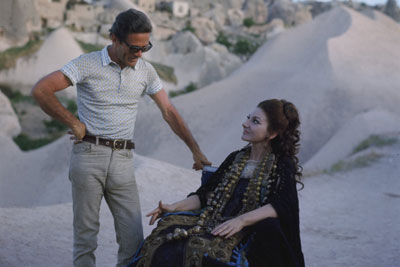In 1968, Franco Rossellini, the producer of Teorema, suggested that Pasolini make a film about Medea, with Maria Callas in the leading role. The director was immediately enthusiastic: he had long thought of involving the famous soprano in a tragic role. Callas, for her part, knew Pasolini as a director and had a confused opinion of him, his films had aroused mixed feelings in her. They met on 19 October 1968 and for Pasolini it was a thunderbolt: Maria was “an extraordinary physical apparition” and he identified her with the heroine of Greek tragedy. Callas is Medea, Medea is Callas and Pasolini wrote the screenplay for the film, carefully calibrating it to her personality. Captivated by Pasolini’s personality, Callas accepts the role of Medea at an extremely delicate moment in her career and life: she has to counteract the many who believe she is professionally finished and she is coming out of her stormy relationship with Aristotle Onassis. The role Pasolini offered her was her chance for redemption, but it was one of the most difficult tests: she felt inadequate, lost, fragmented by the cinematographic technique, so different from the theatrical one in which she was a master. But it is Pasolini’s physical presence on the set in the summer of 1969 that sustains and guides her. The photographs by Mimmo Cattarinich and the unpublished letter in which Pasolini reassures her on a professional and human level document this in an exceptional way. This was only the beginning of a relationship destined to last over time and Pasolini would express his love for her in the ways allowed by his means of expression: poetry and drawing. This led to a large number of portraits of Callas by Pasolini, produced in two series in 1969 and 1970. These drawings are characterised by a strong technical experimentation that deepens the experiences of 1967. The large drawing exhibited here (1970) belongs to a series of eight multiple portraits of Maria Callas made with pencil, wine, glue and rose petals on the beach of the island of Skorpions during a holiday in Greece. Callas’s face becomes an archaic profile in which the inquisitive seriality already tested on himself in 1965, and destined to re-emerge in other portraits of 1974-1975, returns. This drawing, in particular, is made with vinyl glue and anticipates a declaration of 1974: “I couldn’t do anything with pencil, pastels or ink. I took a jar of glue, drew and painted, together, pouring the liquid directly onto the paper. There must be a reason why the idea of attending some art school or academy never occurred to me. Just the idea of doing something traditional makes me nauseous, it literally makes me sick. Even thirty years ago I was creating material difficulties for myself”.
MARIA CALLAS, A PRECIOUS GEM







